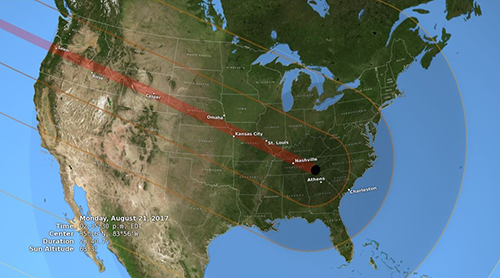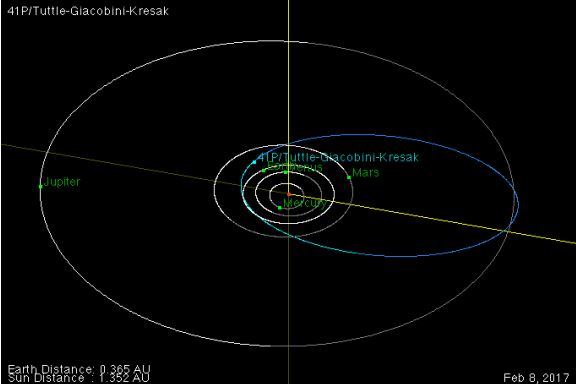
Illustration showing the United States during the total solar eclipse of August 21, 2017, with the umbra (black oval), penumbra (concentric shaded ovals), and path of totality (red) through or very near several major cities. Credit: Goddard Science Visualization Studio, NASA
On August 21, 2017, North Americans will enjoy a rare treat: The first total solar eclipse visible from the continent since 1979. The sky will darken and the temperature will drop, in one of the most dramatic cosmic events on Earth. It could be a once-in-a-lifetime show indeed. But it will also be an opportunity to do some science.
Only during an eclipse, when the moon blocks the light from the sun’s surface, does the sun’s corona fully reveal itself. The corona is the hot and wispy atmosphere of the sun, extending far beyond the solar disk. But it’s relatively dim, merely as bright as the full moon at night. The glaring sun, about a million times brighter, renders the corona invisible.
“The beauty of eclipse observations is that they are, at present, the only opportunity where one can observe the corona [in visible light] starting from the solar surface out to several solar radii,” says Shadia Habbal, an astronomer at the University of Hawaii. To study the corona, she’s traveled the world having experienced 14 total eclipses (she missed only five due to weather). This summer, she and her team will set up identical imaging systems and spectrometers at five locations along the path of totality, collecting data that’s normally impossible to get.
Ground-based coronagraphs, instruments designed to study the corona by blocking the sun, can’t view the full extent of the corona. Solar space-based telescopes don’t have the spectrographs needed to measure how the temperatures vary throughout the corona. These temperature variations show how the sun’s chemical composition is distributed—crucial information for solving one of long-standing mysteries about the corona: how it gets so hot.
While the sun’s surface is ~9980 Farenheit (~5800 Kelvin), the corona can reach several millions of degrees Farenheit. Researchers have proposed many explanations involving magneto-acoustic waves and the dissipation of magnetic fields, but none can account for the wide-ranging temperature distribution in the corona, Habbal says.
You too can contribute to science through one of several citizen science projects. For example, you can also help study the corona through the Citizen CATE experiment; help produce a high definition, time-expanded video of the eclipse; use your ham radio to probe how an eclipse affects the propagation of radio waves in the ionosphere; or even observe how wildlife responds to such a unique event.
Otherwise, Habbal still encourages everyone to experience the eclipse. Never look directly at the sun, of course (find more safety guidelines here: https://eclipse2017.nasa.gov/safety). But during the approximately 2.5 minutes of totality, you may remove your safety glasses and watch the eclipse directly—only then can you see the glorious corona. So enjoy the show. The next one visible from North America won’t be until 2024.
For more information about the upcoming eclipse, please see:
NASA Eclipse citizen science page
https://eclipse2017.nasa.gov/citizen-science
NASA Eclipse safety guidelines
https://eclipse2017.nasa.gov/safety
Want to teach kids about eclipses? Go to the NASA Space Place and see our article on solar and lunar eclipses! http://spaceplace.nasa.gov/eclipses/






